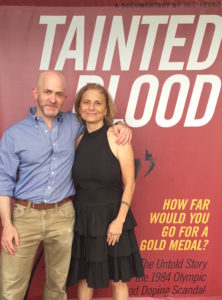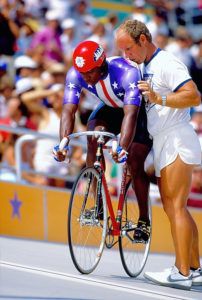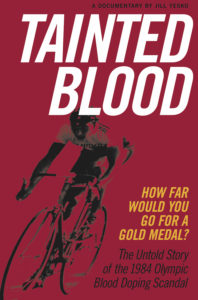Got Bike? See “Tainted Blood.” An Interview with Director Jill Yesko
Written by: Christopher Llewellyn Reed | April 7th, 2018

I met with director Jill Yesko on Friday, March 30, in our joint hometown of Baltimore, to discuss her feature documentary Tainted Blood, which profiles the 1984 bicyclist doping scandal at the 1984 Olympics. The film, Yesko’s debut, presents the facts of the case in a clear, concise manner, revealing that Lance Armstrong was hardly the first (nor, most likely, the last) such athlete to try for an unfair advantage in the sport. The film is a perfect companion to Bryan Fogel’s 2017 Oscar-winning Icarus, which also too on a very similar subject. Yesko – though a novice filmmaker, a veteran journalist – has been traveling the country and the world with her movie, and will present it here in Baltimore this Monday, April 9, at the Parkway Theater, as part of an ongoing “Film Fatales” screening series. Here is a condensed digest of our conversation, edited for clarity.
Film Festival Today: Let’s start out with your background as a journalist. What have you done prior to making this film?
Jill Yesko: I kind of fell into journalism, kind of like the way I fell into filmmaking. I was pursuing a Ph.D. in Cultural Geography, and never finished writing my dissertation. I like to say that that was the last project that went unfinished in my life. If you don’t have a Ph.D., there is no academic career for you.
FFT: Unless you’re in the arts, in which case an M.F.A. is the equivalent degree.
JY: Ah, right. That’s where I went wrong, then. So, with my A.B.D., which equaled zed … (laughs) … I fell into journalism. I’d always written, and so started freelancing, which led to my career writing for many national magazines – long-form journalism – and also being a newspaper reporter, which, I have to say, is great training for being a documentary filmmaker. Right?
FFT: Absolutely.
JY: You know how to ask the questions. And keep asking the questions.
FFT: So, you have this background as a journalist, and you could have chosen any subject for your documentary, why this one?
JY: So, this one has deep personal meaning for me. Before the never-to-be-completed Ph.D., I was a national-class cyclist, and I raced my road bike and my track bike all over the United States, and I lived and raced in Los Angeles, in 1983 and 1984. 1984, in Los Angeles, was huge, because the Olympics were there. I attended the Olympics, I watched the U.S. athletes win a record number of medals, and then, as now, the cycling world was very, very tiny – kind of incestuous – so I knew many of these riders.
I knew their stories, and was absolutely devastated when it came out, about 5 months later, that the riders had blood-doped – infused other people’s blood into their veins – to gain advantage. If you blood-dope, it helps you with your endurance. But we didn’t have the internet then, and, probably more importantly, we didn’t have Lance Armstrong then, so no one really paid attention to the story. So, even in my pre-journalism/pre-filmmaker/pre-documentary brain, I tucked this away. I always knew this was a story I wanted to tell. It just took me many years to do it.
FFT: Understood. So, that explains the access to your subjects, since you were in that world and you knew many of them. Were there any particular challenges that you faced in making this film? People who didn’t want to be a part of it, footage that you couldn’t get?
JY: Yes, yes, and yes! (laughs) Absolutely! So, the first thing is that I naïvely assumed that the riders who blood-doped … and I have to add the caveat that, at the time, it was not, technically illegal, so the riders, according to the letter of the law, had not done anything wrong. Once this story broke, in 1985, blood-doping was quickly made illegal, because it was a huge embarrassment.
FFT: And that’s what got Lance Armstrong in trouble, right?

JY: Among other things, aside from just being a bastard. So, I assumed, since these riders had done nothing wrong, and riders like Lance Armstrong had done so many more heinous things, they would be willing to tell their story. And … I can still hear the sounds of doors being slammed in my face. Which told me two things: 1) they were still deeply embarrassed about what happened, and unwilling to face up to it; and 2) the doping that went on in Los Angeles among the cyclists was more widespread than had been admitted – and I’ve since formally confirmed this – and they were afraid that if they participated in this, it would open up a bigger can of worms.
There was also the small matter of me thinking that, somehow, the United States Olympic Committee – the U.S.O.C. – would be really excited about me doing this project. Also not the case. They denied me access to license footage, which caused a lot of creative and logistical difficulties. You make a documentary about the Olympics, people are going to say, “Where’s your Olympic footage?” How do you get around that?
FFT: You re-enact the Olympics! (laughs)
JY: Well, you know, I have this prejudice against re-creations. I think it looks cheesy.
FFT: Well, I’m not saying you should have done it, but plenty of people do do that.
JY: They do, and perhaps they’re more skillful with it, but … it’s like cilantro: some people love it, some people hate it.
FFT: I happen to like cilantro …
JY: (laughs)
FFT: Animation is another thing that people try. Did you consider that?
JY: I did, and I was bumping up against my budget. You know, I’m a first-time documentary filmmaker, doing a feature doc, and I did it on a shoestring, and every time I got to a certain level, it was like, “OK, another $10,000. Oh, look! For another $10,000, you can get this.” SO, I had to, eventually, stop coughing up $10,000 and shaking the tree for the money.
FFT: So, did you fund this film entirely on your own, or did you have Kickstarter campaign, or some other kind of crowdfunding source?
JY: I did. I did crowdfunding, which paid for some of the extensive traveling that I had to do. I was also working full-time in a non-filmmaking job that was funding my passion project. And interestingly, it got to the point where I said, “You know what? It’s either the job or the film.” Because I couldn’t wait another two years to birth this, so the last year, I quit my job, and did this full-time.
FFT: Wow. What was the job you quit?
JY: I was doing public relations in higher education.
FFT: And you left that to devote yourself to the film.
JY: I did.
FFT: So, all of that explains the aesthetic choices in your film. You have a lot of talking-head interviews, and then some archival footage – some footage of people bicycling – but you really had to, out of necessity, make the film this way.
JY: I did. I did spend a long time … there are a lot of stills in the film, and I spent much of my time and energy chasing those down.
FFT: Were those easier to get rights to than the video footage?
JY: They were, because, again, I knew people in cycling. I knew the photographers, and they supported the project, so they were able to license the stills at a discounted cost for me.

FFT: So, what has been your marketing strategy for this film? What have you been doing to get it out? What has been your chosen path for the movie?
JY: So, I have entered it into some festivals. As you know, there is a plethora of niche festivals and, not surprisingly, the International Cycling Film Festival said, “Yes. Please come to Barcelona and screen it.” So, that was a great festival, and that was in October of 2017. The film is kind of a little deep – it is talking heads and kind of geeky, for cyclists – and I’ve had tremendous success arranging my own screenings in bike shops.
FFT: That seems like an innovative marketing strategy. You have this niche film; go to bike shops to get people to see it.
JY: And that’s been super successful. A lot of bike shops have diversified now: they’re kind of what are called now “club houses,” where they serve beer and food, and sell clothing, and so those are the places that I have targeted. And naturally, they attract cyclists. They help me package this and put this together. So, we had a great screening in Boulder, Colorado, which is ground zero for Olympic cyclists.
FFT: Are you able to sell the film at these screenings, on disc, or does that come later?
JY: The film is on Amazon, and I track it and it’s getting a lot of tracking in Europe. People are renting it, but because of Amazon’s revised pay strategy, I make all of $20 a month on it. But the return on investment for this film, in every way but monetary, has been huge. I’ve met great people. I believe I’ve developed a market for my next film.
FFT: Indeed. That can be the best reward, because now people know you.
JY: Yes.
FFT: And this may then open doors for your next film.
JY: My mom is very proud of me. Does that count?
FFT: It does! So, congratulations on the film. I enjoyed watching it, and I wish you continued success with it, going forward.
JY: Thank you very much!

